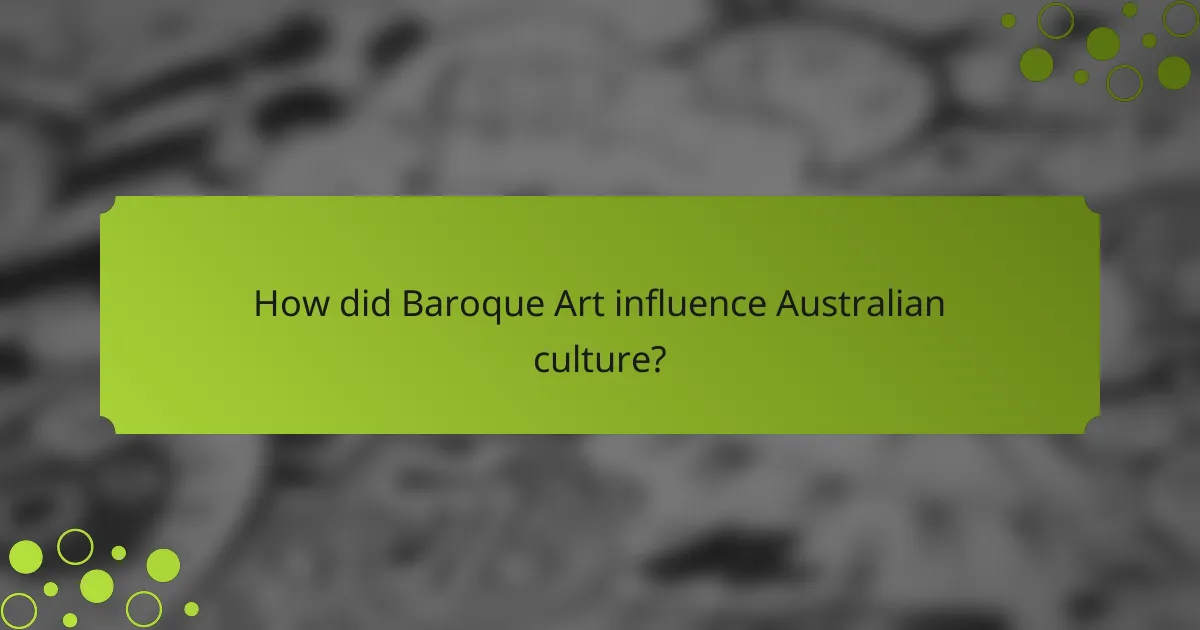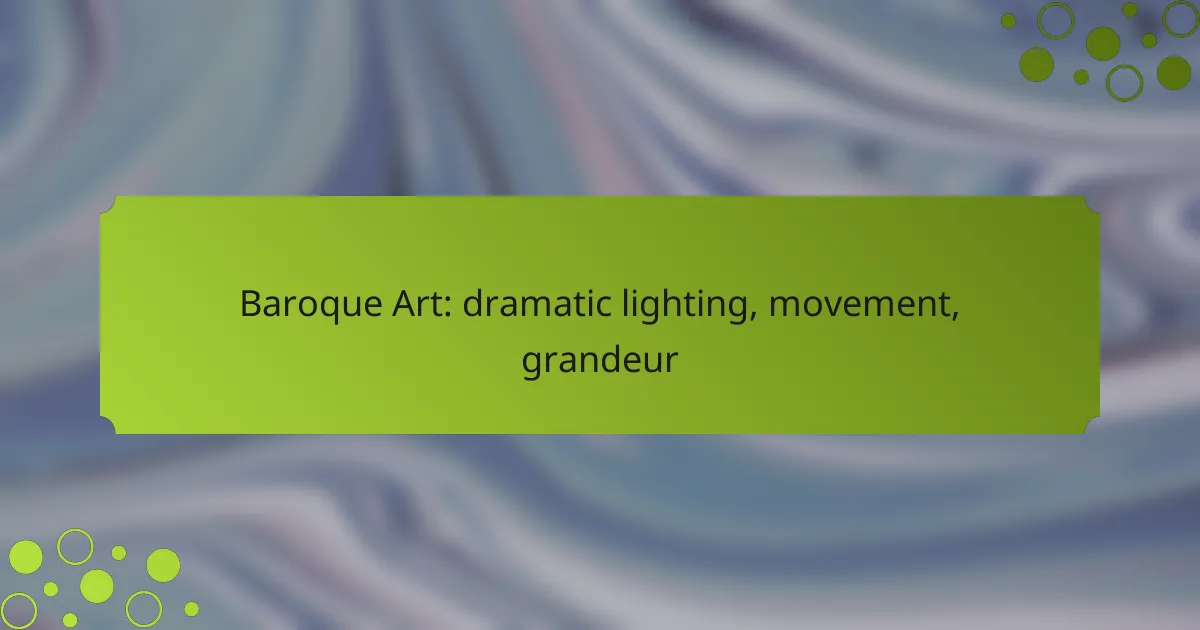Baroque Art is renowned for its dramatic use of lighting, which creates striking contrasts that enhance emotional depth and movement within the artwork. This style embodies grandeur and theatricality, drawing viewers into a dynamic experience that conveys a sense of action and intensity. Prominent artists like Caravaggio and Rembrandt exemplified these techniques, leaving a lasting impact on the art world.

How does Baroque Art use dramatic lighting?
Baroque Art employs dramatic lighting to create intense contrasts between light and shadow, enhancing emotional depth and movement in the artwork. This technique draws the viewer’s eye to focal points, amplifying the grandeur and theatricality characteristic of the Baroque style.
Chiaroscuro techniques
Chiaroscuro is a technique that uses strong contrasts between light and dark to give the illusion of volume in modeling three-dimensional objects and figures. In Baroque Art, artists skillfully manipulate light to highlight specific elements, creating a sense of drama and depth. This method not only enhances realism but also evokes emotional responses from the viewer.
Symbolism of light and shadow
In Baroque Art, light often symbolizes divine presence or enlightenment, while shadow can represent sin or ignorance. This interplay serves to convey complex narratives and moral themes within the artwork. The strategic use of light and shadow helps to guide the viewer’s interpretation and emotional engagement with the piece.
Examples from Caravaggio
Caravaggio is renowned for his masterful use of dramatic lighting, particularly through chiaroscuro. In works like “The Calling of Saint Matthew,” he employs a sharp contrast between the illuminated figures and the dark background, emphasizing the moment of divine intervention. His innovative approach not only influenced his contemporaries but also set a standard for future generations of artists in the Baroque period.

What are the key characteristics of Baroque Art?
Baroque Art is characterized by its dramatic use of lighting, dynamic movement, and a sense of grandeur. These elements work together to create emotionally charged pieces that engage viewers and convey a sense of action and depth.
Emphasis on movement
Baroque Art places a strong emphasis on movement, capturing dynamic poses and gestures that suggest action. Artists often used swirling drapery and contorted figures to create a sense of energy and fluidity in their compositions.
This movement is not just physical but also emotional, as the figures often appear to be caught in the midst of intense experiences. For example, in works by artists like Caravaggio and Bernini, the figures seem to leap off the canvas or out of the marble, drawing viewers into the scene.
Grand scale and detail
The grandeur of Baroque Art is evident in its large-scale works and intricate details. Artists frequently created expansive compositions that filled entire walls or ceilings, often in churches and palaces, to inspire awe and reverence.
In addition to scale, the attention to detail is remarkable, with artists meticulously rendering textures, fabrics, and backgrounds. This combination of size and detail enhances the overall impact of the artwork, making it visually striking and immersive.
Emotional intensity
Emotional intensity is a hallmark of Baroque Art, as artists sought to evoke strong feelings in their audience. Through dramatic lighting, expressive faces, and poignant scenes, Baroque works often depict themes of struggle, faith, and redemption.
For instance, the use of chiaroscuro—contrasting light and shadow—intensifies the emotional experience, guiding the viewer’s focus to key elements of the composition. This technique, combined with the portrayal of human emotion, creates a powerful connection between the artwork and its audience.

Which artists are prominent in Baroque Art?
Prominent artists in Baroque Art include Caravaggio, Peter Paul Rubens, and Rembrandt van Rijn. Each of these masters contributed unique styles and techniques that defined the dramatic lighting, movement, and grandeur characteristic of the Baroque period.
Caravaggio
Caravaggio is renowned for his innovative use of chiaroscuro, which creates a stark contrast between light and dark. This technique not only enhances the emotional intensity of his subjects but also draws the viewer’s eye to focal points in his compositions.
His works often depict religious themes with a raw realism that was groundbreaking for his time. Notable pieces like “The Calling of Saint Matthew” showcase his ability to capture movement and drama, making the viewer feel part of the scene.
Peter Paul Rubens
Peter Paul Rubens is celebrated for his dynamic compositions and vibrant color palettes. His paintings often feature grand historical and mythological themes, infused with a sense of movement that brings the figures to life.
Rubens’ style is characterized by lush, flowing forms and a mastery of light that creates a sense of depth. Works such as “The Elevation of the Cross” exemplify his ability to convey both grandeur and emotional depth, making him a key figure in Baroque Art.
Rembrandt van Rijn
Rembrandt van Rijn is known for his profound exploration of human emotion and the use of light to enhance narrative depth. His portraits, such as “The Night Watch,” demonstrate a unique ability to capture the essence of his subjects through subtle lighting and detailed expressions.
His innovative approach to texture and shadow adds a three-dimensional quality to his work, inviting viewers to engage with the scene. Rembrandt’s legacy in Baroque Art lies in his ability to blend realism with dramatic storytelling, making his pieces timeless.

How did Baroque Art influence Australian culture?
Baroque Art significantly influenced Australian culture through its dramatic aesthetics, which are reflected in various artistic expressions and architectural styles. The grandeur and emotional intensity of Baroque elements can be seen in colonial architecture, public art, and exhibitions across the country.
Impact on colonial architecture
Baroque Art’s influence on colonial architecture in Australia is evident in the use of grandiose designs and elaborate detailing. Buildings such as churches and government structures often feature ornate facades, large domes, and intricate carvings that echo Baroque principles. This architectural style aimed to convey power and authority, mirroring the aspirations of colonial society.
Examples include St. Mary’s Cathedral in Sydney, which showcases Baroque-inspired elements, and the State Library of Victoria, reflecting the grandeur associated with this artistic movement. Such structures not only serve functional purposes but also act as cultural landmarks that embody historical significance.
Integration in public art
Baroque Art’s dramatic flair has been integrated into public art installations throughout Australia, enhancing the visual landscape of cities. Sculptures and monuments often draw on Baroque themes of movement and emotion, creating dynamic focal points in public spaces. This integration fosters a connection between the past and present, inviting reflection on cultural heritage.
For instance, the impressive “Captain Cook” statue in Sydney features Baroque-inspired elements that celebrate exploration and adventure. Public art festivals frequently highlight these influences, encouraging artists to experiment with Baroque styles in contemporary contexts.
Exhibitions in Australian galleries
Australian galleries frequently showcase exhibitions that explore Baroque Art, providing insights into its historical context and artistic techniques. These exhibitions often feature works from both local and international artists, highlighting the enduring appeal of Baroque aesthetics. Visitors can engage with the dramatic lighting and movement characteristic of this style, enhancing their appreciation of its impact on art history.
Major institutions like the National Gallery of Australia have hosted Baroque-themed exhibitions, allowing audiences to experience the grandeur of this art form firsthand. Such events not only educate the public but also inspire contemporary artists to incorporate Baroque elements into their own work, ensuring its legacy continues in modern Australian culture.

What are the prerequisites for studying Baroque Art?
To study Baroque Art effectively, a foundational understanding of earlier artistic movements, particularly the Renaissance, is essential. Familiarity with art history terminology also enhances comprehension of Baroque techniques and themes.
Understanding of Renaissance influences
The Baroque period, spanning from the late 16th century to the early 18th century, was heavily influenced by Renaissance ideals. Artists like Caravaggio and Bernini drew on the techniques of perspective, naturalism, and human emotion that were perfected during the Renaissance.
Recognizing these influences helps in appreciating how Baroque artists expanded on these concepts, introducing dramatic lighting and movement. For instance, while Renaissance art often emphasized balance and harmony, Baroque art embraced tension and dynamism, creating a sense of grandeur.
Familiarity with art history terminology
Understanding key art history terms is crucial for analyzing Baroque works. Terms such as chiaroscuro (the use of strong contrasts between light and dark) and tenebrism (a dramatic illumination technique) are fundamental to grasping the visual language of Baroque art.
Additionally, being familiar with concepts like foreshortening and composition will aid in recognizing how Baroque artists achieved their distinctive effects. This knowledge allows for deeper engagement with artworks, enhancing both appreciation and critical analysis.
